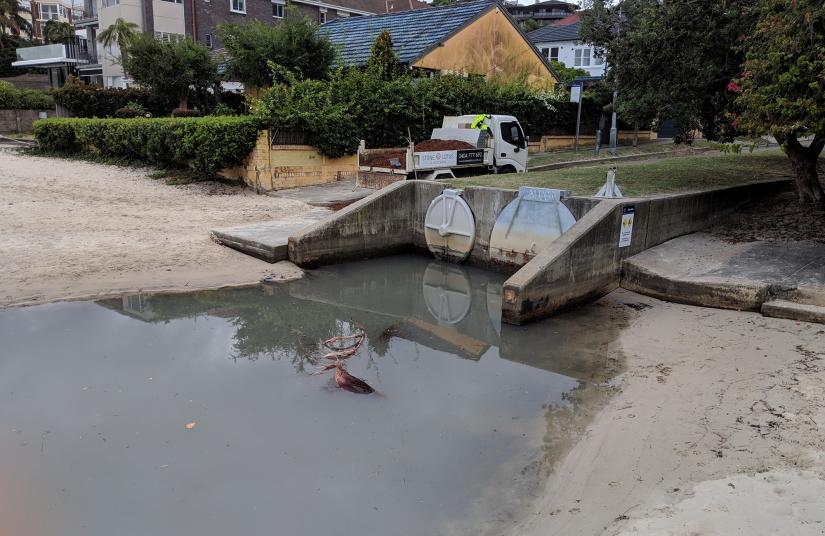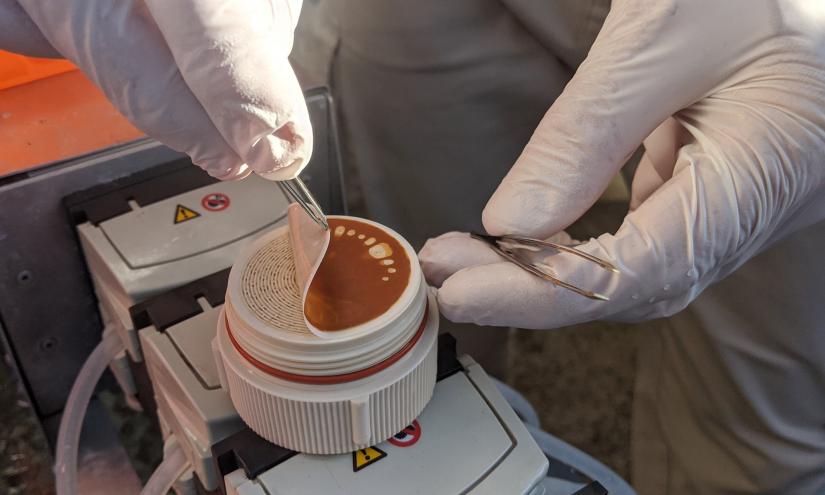A new research collaboration has used sophisticated DNA marker approaches to determine the primary cause of poor water quality at beaches. And guess what? It’s us.

Researchers found several stormwater drains at Rose Bay were contaminated by sewage, even in dry weather. Photo by Nathan Williams
Is it bird poo? Is it dog poo? Is it human poo?
These are important questions when trying to work out the causes of water contamination at popular Sydney swimming spots. Sadly, in the case of the beaches of Rose Bay and Terrigal, it is human poo, in the form of sewage contamination, which has the biggest impact on water quality.
A new research collaboration involving the Ocean Microbiology Group, in the Climate Change Cluster (C3) at the University of Technology Sydney (UTS), along with the NSW Department of Planning, Industry and Environment (DPIE), Beachwatch and Central Coast Council, has identified sewage as the primary cause of poor water quality.
Ocean Microbiology Group leader Professor Justin Seymour, his PhD student Nathan Williams and post-doctoral research associate Dr Nahshon Siboni used sophisticated DNA marker approaches to analyse samples of stormwater and seawater for human, bird and dog faeces.

Researchers filtered drain water to collect bacteria for later DNA extraction and downstream analysis. Photo by Nathan Williams
Previously, ambiguity about the sources of water contamination has hampered efforts to manage water quality at several Sydney beaches. Standard water-quality monitoring programs have been unable to distinguish between human and animal faecal matter as the source of bacteria such as Enterococci.
The researchers collected seawater samples before, during and after significant rainfall events at Rose Bay in Sydney Harbour [opens external site] and Terrigal Beach on the Central Coast [opens external site].
The team found that even in dry weather, several stormwater drains at Rose Bay were contaminated by human faecal matter, or sewage.
However, after 43mm of rain, Rose Bay’s water quality declined sharply, with bacteria levels in drains and several near-shore water samples exceeding the highest microbial health risk level set by the National Health and Medical Research Council (NHMRC).
Traditional approaches for measuring water quality at beaches often result in ambiguity about the source of contamination.
Professor Justin Seymour
Markers for dog faeces were also found, but in much lower concentrations than human faecal markers. Bird faeces were not found to have a notable effect on water quality.
At Terrigal Beach, the researchers found water quality in dry weather was generally good, with bacteria at the lowest NHMRC health risk level and DNA markers for human and animal faecal material at low or undetectable levels.
However, sewage markers rose substantially after 20mm of rain, with the highest contamination levels observed within stormwater drains and adjacent seawater samples, and within Terrigal Lagoon. Samples collected as far as 300m offshore showed high levels of sewage indicators.

Terrigal Haven on a dry weather sampling day for the research team. Photo by Nathan Williams
“Traditional approaches for measuring water quality at beaches often result in ambiguity about the source of contamination because they cannot discriminate human faeces (sewage) from animal sources of faecal contamination,” Professor Seymour said.
“Our approach uses molecular microbiological tools to discriminate and measure bacteria that are specific to human (sewage) and animal (e.g. dog, bird) faeces, which provides a better perspective for determining the causes of contamination and developing strategies to manage coastal water quality.
“These approaches allowed us to pinpoint the places and times where sewage contamination is the principal cause of reduced water quality.”
We know the ‘poor’ water quality grade given to Rose Bay and Terrigal beaches has caused concern for families and other beach users.
Dr Meredith Campey
Department of Planning, Industry and Environment Beachwatch Programs Manager, Dr Meredith Campey, said the results will enable beachgoers to continue to enjoy their beaches over summer, knowing where and when it is safe to swim.
“We know that the ‘poor’ water quality grade given to Rose Bay and Terrigal beaches in recent annual State of the Beaches reports [opens external site] has been a cause of considerable concern for families and other beach users in the local area over the past few years,” Dr Campey said.
“This research will ensure that local councils and water utilities are equipped with the right information to ensure the best, most effective solutions can be delivered to improve water quality at these popular beaches.”

